![]()
![]()
![]()
Use LEFT and RIGHT arrow keys to navigate between flashcards;
Use UP and DOWN arrow keys to flip the card;
H to show hint;
A reads text to speech;
34 Cards in this Set
- Front
- Back
|
When do the testicles of horses descend and via what? |
270-300 days of gestation via the gubernaculum into the inguinal canal from just caudal to kidneys. |
|
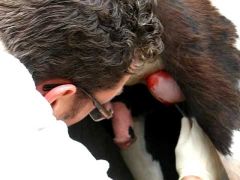
How is the open method of castrating a male horse carried out? |
Standing where external tunic is incised and left open. |
|
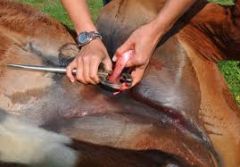
How is the closed method of castrating a male horse carried out? |
GA. External tunic closed proximally by a ligature prior to testis removed. |
|
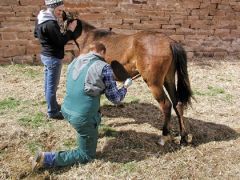
When do we not perform a standing castration?
|
Mature stallion >4 years old as greater risk of hemorrhage and evisceration.
History of inguinal herniation. Cryptorchid. Donkey. Fractious. |
|
|
What must we always check for before castration? |
2 testicles and absence of hernias.
|
|
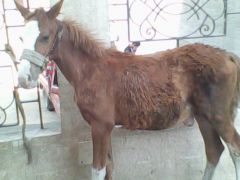
Advise to an owner with a foal with an inguinal hernia? |
Most are self resolving by 6 months. Tell owner low risk of bowel incarceration. Tell owner to manually reduce daily. Advise of signs of rupture or bowel incarceration: Cold clammy scrotum. Colic/depressed. Irreducible. |
|
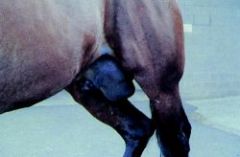
Difference between inguinal hernias in foals and adults?Treat? |
In adults usually in stallions after breeding/exercise. Usually non reducible with strangulating bowel. Signs: severe colic, with severe swelling, cold clammy scrotum, ultrasound shows guts, rectal and feel guts in inguinal region. Treat: colic surgery and castrate. |
|
|
How should we castrate a horse with a hernia? |
Closed under GA in dorsal recumbency so bowel falls back into abdomen. Twist vaginal tunic so bowel goes into the abdomen. Transfixing suture as low as possible to prevent recurrence. |
|
|
What are the preparation steps for a standing castration? |
1) History and clinical exam for any herniation. 2) I/V sedation and analgesia. 3) Local anaesthetic into the cord and scrotum and possibly testes. 4) Antibiotics. 5) Tetanus 6) Clean scrotal area thoroughly with disinfectant. |
|
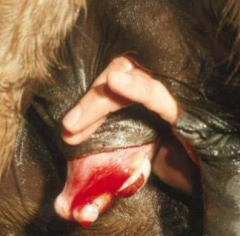
Where do we cut on the anaesthetised testes and what are our next steps? |
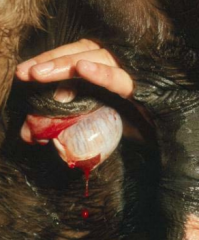
Cranio-caudal direction on the midline deep. Through: scrotal skin--> dartos-->parietal tunic. Exteriorise testicle by pressure. |
|
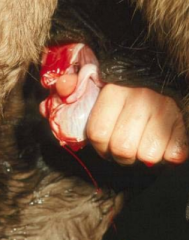
After exteriorising our testicle what do we do? |
Section/split avascular ligament of the tail of the epidydymis |
|

After section/ spliting the avascular ligament of tail of the epidydymis what do we do? Risks of placing ligatures and pros? |
Transect and crush the spermatic cord with emasculators held in place for 2-4 minutes.
Remove testicle. Risks of placing ligatures include: contaminated wound so can lead to infection but pro is better haemostasis. |
|
|
Pros and cons of open castration? |
Pros: cheaper and no risks of GA also quicker. Cons: Increased risk of haemorrhage, eventration, infection compared to closed. |
|
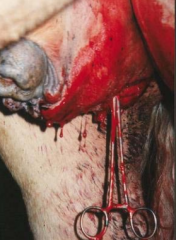
What is normal wound haemorrhage from a standing open castration?
|
Drips for an hour after. Should be able to count drops. SHOULDN'T BE A STREAM!!!!!!!!!!!!! |
|
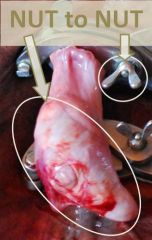
Reasons for hemorrhage after an open castration? |
Emasculator on wrong way round- NUT TO NUT! Emasculator inappropriate size. Emasculator not held on long enough. Emasculator worn out. Unlucky/ |
|
|
If we have haemorrhage after our open castration what do we do? |
Remain calm. Resedate. Sterile guaze to pack scrotum. If doesn't stop hunt for the stump and grasp with artery forceps leave in place for 24 gours. Unsuccessful GA and laparoscopy. |
|
|
Pros of closed castration? |
Minimal risk of evisceration, eventration, prolapse. Sterile ligatures place- less risk of haemorrhage and infection. Better surgical asepsis. |
|
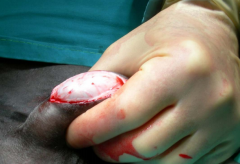
Steps to perform a closed castrate? |
Incise both scrotums or one down through skin and dartos, shiny tunic intact. Dissection aided by swabs. 2 transfixing ligatures applied with absorbable suture material. Emasculate 2 cm distally to ligatures. Allow cord to slowly retract down into canal and check there is no haemorrhage. If any concern of contamination or sterility leaven partially open otherwise fully close with absorbable suture. |
|
|
Post operative care for a castrated horse? |
NSAIDS.
Antibiotics? Walk out--> reduced oedema. Observe scrotum frequently during 1st 24 hours. |
|
|
Signs of scrotal infection? |
Common complication esp in standing as done in dirty environment.
Febrile. Swollen scrotum and prepuce. Stiff hindquarters. Exudation. |
|
|
Predisposing factors to scrotal infection post castration? |
Contamination during surgery. Ligatures in non sterile site. Dirty environment. Small or lateral scrotal incisions. |
|
|
How do we treat scrotal infections?
|
Ensure adequate drainage. Clean out infected clots from scrotum. Lavage scrotal interior-low pressure. Systemic A/B. |
|
|
Chronic infections of the scrotum?
|
Champignon- granulation tissue that protrudes out- open up and evacuate 3 day course of penicillin. Funiculitis is a grossly infected spermatic cord that needs resecting. Scirrhous cord- granulomatous tracts needs GA and removal! Staph infection. |
|
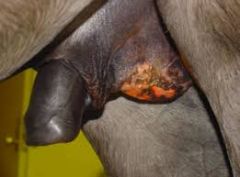
Signs of a scirrous cord? |
Swollen scrotum with draining sinus tract. Small amounts of discharge. Palpate hard swelling in scrotum or inguinal region. |
|
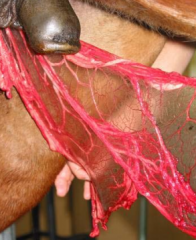
Other complications of castration? Which is a surgical emergency? |
Evisceration of omentum, dartos. SI. Haematoa. Intestinal evisceration is a surgical emergency!!! |
|
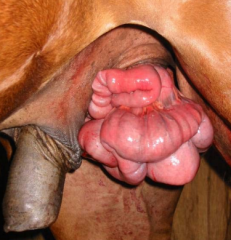
How do we emergency manage prolapsed intestine? |
Sedate horse. Small amount intestine try suture scrotum closed. Large amount support guts with damp pillow cover or sheet. A/B and NSAID. Refer to nearest centre who replace under GA, suture the vaginal tunic closed. |
|

Which horse is predisposed to cryptorchidism? |
Ponies esp. Welsh ponies. |
|
|
Where is the retained testicle usually? |
Inguinal canal between internal and external ring known as a high flanker.
|
|
|
On clinical exam and history what do we focus on with a rig? |
Careful history to ensure its been from birth and not just castrated on one side. Palpation for scars. Ultrasound to find testicle. If in doubt blood test. |
|
|
In horses >3 years old how do we diagnose a rig? |
Resting plasma oestrone sulphate assay to see if testicular tissue present. <50 pg/ml in geldings. >400 pg/ml rig. |
|
|
In horses <3 years old how do we diagnose a rig? |
Testosterone levels with HCG stim. |
|
|
Methods of surgically removing a retained testicle? |
GA, dorsal and open.
Standing/ GA laparoscopy. |
|
|
Steps to performing a retained testicle? |
Incision over external inguinal canal between the hindlimb and abdomen. Avoid large pudendal veins once through deep fascia. Bluntly dissect around external ring. Bluntly dissect down inguinal canal. Locate shiny vaginal process a blind pocket of external tunic. Cut open external tubic and exteriorise structures. Ligate and remove. |
|
|
How does the retained testicle look? |
Smaller and flaccid. |

